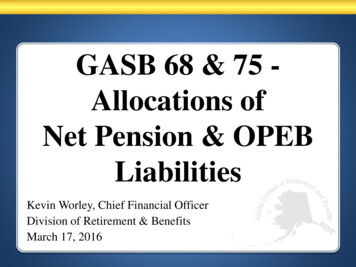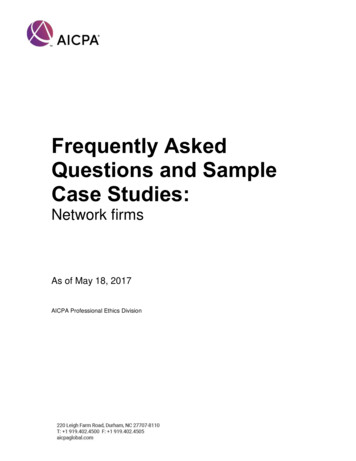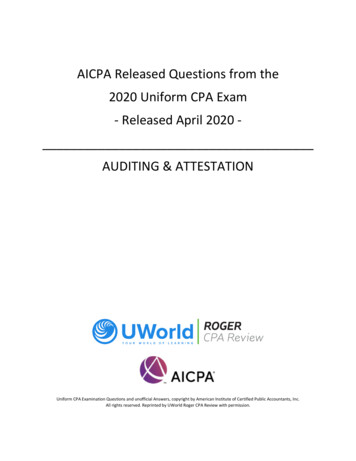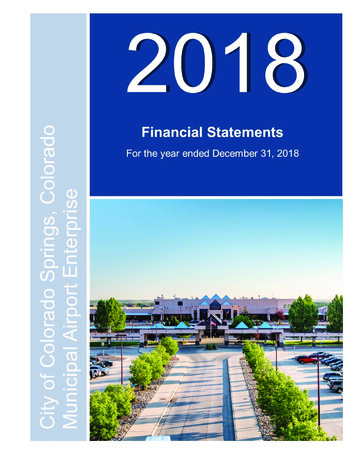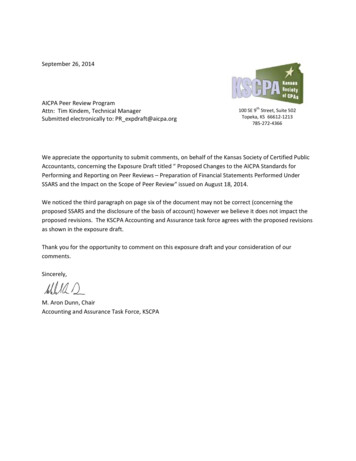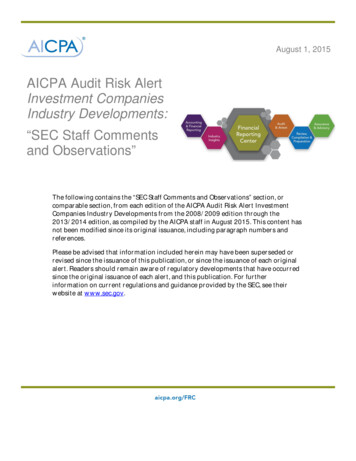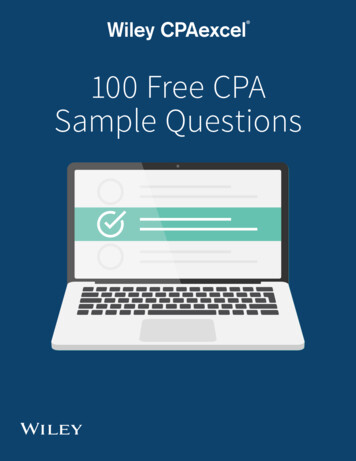
Transcription
GAQC Web Event: OPEB ‐ GASB 75:Special Emphasis and Considerations for Nontrusted PlansOctober 10, 2017OPEB - GASB 75:Special Emphasis and Considerationsfor Nontrusted PlansA Governmental Audit Quality Center Web EventOctober 10, 2017Administrative Notes Please ensure your pop-up blocker is disabled. Note the interactive toolbar at the bottom of your screen. Download slides and materials by clicking this icon. Ask questions by entering your question in the “Q&A” box. Please click the “Help”bottom of your screen.and/or “Contact Us”at the Call AICPA Member Service at 888.777.7077.2Trouble Shooting No Audio?– Ensure computer speakers are turned on and volume isappropriately set– Ensure that audio streaming is enabled on your computer If the presentation slides stop advancing during the presentation– Close out of the presentation and re-launch the webcast If you are still having audio or other technical difficulty– Check with your IT personnel to ensure that this event is notbeing blocked by a firewall– Call the AICPA Service Center at 888.777.707731
GAQC Web Event: OPEB ‐ GASB 75:Special Emphasis and Considerations for Nontrusted PlansOctober 10, 2017Continuing Professional Education You must answer at least 75% of the random, attendance checksto earn CPE credit. Please respond to the attendance checks during the livepresentation. You are not eligible to earn CPE by watching the archive of thisevent. At the end of today’s presentation we will provide steps forobtaining your CPE certificate4PresentersJoel Black, CPAMauldin & Jenkins CPAs, LLCStephen W. Blann, CPA, CGFM, CGMARehmann, LLC5What We Will Cover How the new other postemployment benefits (OPEB)requirements differ from GASB's requirements for pensions The differences in accounting treatment when OPEB isadministered through a trust versus when it is not administeredthrough a trust The significant inputs and assumptions to OPEB elements Auditing considerations from the employer auditor's perspectivewith an emphasis on audit evidence relevant to OPEB notadministered through a qualifying trust (nontrusted plans)62
GAQC Web Event: OPEB ‐ GASB 75:Special Emphasis and Considerations for Nontrusted PlansOctober 10, 2017OPEB BasicsA 10,000 foot view of the standardsGASB Statements 74/75OPEB BasicsFor detailed explanation of OPEB accounting and anillustrative journal entry view the GAQC archived web eventtitled, “GASB 75 OPEB Implementation: Accounting andAuditing Considerations” available on the GAQC web site. GASB 74 (effective 06/30/2017)– Applies to the financial statements of OPEB plans (OPEB trustfunds) GASB 75 (effective 06/30/2018)– Applies to the financial statements of employers providingOPEB8GASB Statements 74/75Defining Pension & OPEB Pensions– Retirement income and benefits (other than healthcare)provided through a pension plan93
GAQC Web Event: OPEB ‐ GASB 75:Special Emphasis and Considerations for Nontrusted PlansOctober 10, 2017GASB Statements 74/75Defining Pension & OPEB OPEB– All postemployment healthcare benefits– Medical, dental, vision, hearing, etc.– Regardless of whether provided by a pension plan– Postemployment benefits other than retirement income notadministered by a pension plan– Death benefits, life insurance, disability, long-term care– Excludes termination benefits10GASB Statements 74/75Defining Pension & OPEB Termination benefits (GASB 47):– An inducement to hasten the termination of services (e.g.,early retirement incentives)– May be voluntary or involuntary– Requires professional judgment to determine employer’s intentand employee’s understanding– Recorded at the NPV of the benefits to be paid when theagreement is made (not OPEB)11GASB Statements 74/75Defining Pension & OPEBPensions OPEB GASB has determined that OPEB plans are conceptually similarto pensions, and has largely replicated the guidance from GASB67/68 in GASB 74/75– Incorporates amendments from GASB 71 and 73– Retains requirement for actuaries to consider the implicit ratesubsidy– Retains the option for small plans to use the alternativemeasurement method124
GAQC Web Event: OPEB ‐ GASB 75:Special Emphasis and Considerations for Nontrusted PlansGASB Statements 74/75October 10, 2017Pensions OPEBNet OPEB Liability (NOL) Recorded by the employer (not the plan) Equal to the actuarially determined total OPEB liability (TOL),less the net position of the OPEB trust fund– Nontrusted plans just report the TOL Recorded in full accrual financial statements [certain portions areoffset by deferred outflows/inflows of resources (deferred O/I)and amortized]13GASB Statements 74/75Pensions OPEBTOL Calculated by the actuary:– Project future benefits– Discount to present value– Attribute present value to specific periodsHireTodayRetirementDeath14GASB Statements 74/75Pensions OPEBTOL Calculated by the actuary:– Project future benefits– Discount to present value– Attribute present value to specific periodsFuture BenefitsHireTodayRetirementDeath155
GAQC Web Event: OPEB ‐ GASB 75:Special Emphasis and Considerations for Nontrusted PlansGASB Statements 74/75October 10, 2017Pensions OPEBTOL Calculated by the actuary:– Project future benefits– Discount to present value– Attribute present value to specific periodsDiscount RateHireTodayFuture BenefitsRetirementDeath16GASB Statement 74/75Pensions OPEBTOL Calculated by the actuary:– Project future benefits– Discount to present value– Attribute present value to specific periodsService CostTOLHireDiscount RateTodayFuture BenefitsRetirementDeath17GASB Statements 74/75Key Actuarial ChangesPensions OPEB Actuarial cost method– Entry Age, Level Percent of Pay– Project future benefits using age-adjusted premiums (implicitrate subsidy) Small plans (fewer than 100 members) may use the alternativemeasurement method that does not require an actuary186
GAQC Web Event: OPEB ‐ GASB 75:Special Emphasis and Considerations for Nontrusted PlansGASB Statements 74/75Key Actuarial ChangesOctober 10, 2017Pensions OPEB Expected return/discount rate– Single blended rate comprised of:– Expected rate of return (years w/ sufficient assets)– AA 20 year muni bond rate (years w/ insufficient assets)– A lower discount rate produces a higher liability and vice versa19GASB Statements 74/75Key Actuarial Changes Amortization of unfunded liability– GASB 45 permitted wide latitude in amortization periods– GASB 75 requires:Pensions OPEB– Plan changes – immediately– Assets returns other than expected – 5 years– Other actuarial liability gains and losses – average futureservice life of all plan members (including inactives)20GASB Statements 74/75Key Actuarial Changes Sensitivity analyses– Changes in the discount rate– Changes in the healthcare cost trend rate217
GAQC Web Event: OPEB ‐ GASB 75:Special Emphasis and Considerations for Nontrusted PlansGASB Statements 74/75October 10, 2017Pensions OPEBMeasurement Date (MD)If not already as of MD, actuarial valuation must be rolledforward to MDPotential MDsPotential Actuarial Valuation Dates12/31/156/30/166/30/176/30/18Thirty Months and a day beforecurrent year-endyEmployer Current YearEndGASB 74 - Employer StandardGASB 75 - Plan StandardMeasurement of the TOL in employer’s financialstatements must be as of a date no earlier than the end ofthe employer’s prior fiscal year.Measurement of the TOL in plan’s financial statementsmust be as of the plan’s fiscal year end.Measurement must be based on an actuarial valuationperformed within 30 months plus 1 day of the employer’syear-end. If actuarial valuation not performed as of MD,update procedures must be performed to roll forwardamounts to MD.Measurement must be based on an actuarial valuationperformed with 24 months of the plan’s year-end. Ifactuarial valuation not performed as of the MD, updateprocedures must be performed to roll forward amountsto MD.22GASB Statements 74/75MD ConsiderationsPensions OPEB A good MD should:– Facilitate timely financial reporting– Minimize the need for roll-forwards from the valuation date– Facilitate a quality actuarial valuation by:– Allowing ample time for the gathering of related census and claimsdata– Coincide adequately with the plan year to be able to incorporate themost recent changes in plan provisions.– Avoid different MDs for plan and employer when plan financialstatements are included in the employer’s financial statements.23Determining OPEB ExpensePensions OPEB GASB defines OPEB expense almost identically to that ofpensions:– Begin with the change in liability from beginning to ending MD– Defer any amounts specifically required by GASB 75– Actuarial gains (inflows) and losses (outflows)– Difference between expected and actual investment returnN/A fornontrust– Defer an outflow for contributions (trust) or employer OPEBpayments (non-trust) made subsequent to the MD– Amortize and recognize into expense deferred O/I fromprevious years248
GAQC Web Event: OPEB ‐ GASB 75:Special Emphasis and Considerations for Nontrusted PlansOctober 10, 2017Recap of GASB 75 ReportingDescriptionTrust meeting par. 4Non-Trust1Recognize in Statement of NetPositionNOLTOL2Present Value for TOLdetermined using:Long term rate of return (LTROR) or singleblended rate of LTROR and AA 20 yearMunicipal Bond IndexAA 20 year municipal bond index3Recognize in Statement of NetPositionDeferred O/I for both TOL and InvestmentsDeferred O/I for TOL only4Recognize in Statement of NetPositionDeferred outflow for contributions after MDDeferred outflow for OPEBpayments after MD5OPEB related assetsRecorded in Plan FS and used to determine Recorded in appropriatePlan Fiduciary Net Positiongovernmental or proprietary fund6OPEB expenseChange in the NOL with appropriatedeferrals and amortizationChange in TOL with appropriatedeferrals and amortization25Employer Note Disclosures – DescriptionsABCDName of plan, administrator of plan, and type of planPlan Description Benefit terms, including (1) classes of employees covered, (2) types ofbenefits, (3) key elements of OPEB formula, (4) terms or policies withrespect to automatic benefit changes, including ad hoc cost of livingadjustments (COLAs), (5) legal authority Number of employees covered A Trusted:Single/AgentB Trusted: Costsharing Fact that no assets accumulated in a trust Contribution requirements, including (1) authority under whichcontributions made, (2) legal or maximum contributions rates, (3)contribution rates, and (4) contributions made C Non-TrustedSingleAuthority under which to pay OPEB benefits as they come due andamount Availability of audited plan financial statements D Non-TrustedPrimary Govt (PG) Component Unit(CU) (stand-alone reports only)26Employer Note Disclosures – AssumptionsAssumptions and Other InputsABCDSignificant assumptions, including inflation, healthcare cost trend rates,salary changes, postemployment benefit changes Source of mortality assumptions Dates of experience studies Fact that projections of sharing of benefit costs based on establishedpattern of practice NOL sensitivity to healthcare cost trend rate ( 1%) TOL sensitivity to healthcare cost trend rate ( 1%)A Trusted:Single/AgentB Trusted: CostsharingC Non-TrustedSingle D Non-TrustedPG CU(stand-alone reports only)279
GAQC Web Event: OPEB ‐ GASB 75:Special Emphasis and Considerations for Nontrusted PlansEmployer Note Disclosures – Discount RatesABCDDiscount rate usedDiscount Rate Assumptions about projected cash flows Long-term expected rate of return on plan investments and howdetermined Municipal bond rate used Periods of projected benefit payments applied to long-term rate of returnand municipal bond rate, if applicable Assumed asset allocation and long-term expected real rate of return foreach major asset class NOL sensitivity to discount rate ( 1%) October 10, 2017A Trusted:Single/AgentB Trusted: Costsharing C Non-TrustedSingleTOL sensitivity to municipal bond rate ( 1%) D Non-TrustedPG CU(stand-alone reports only)28Employer Note Disclosures – Additional ItemsABInformation about plan’s fiduciary net position if report not publiclyavailableAdditional Disclosures Schedule of changes in NOL Schedule of changes in TOLCD MD Actuarial valuation date Employers proportionate share of net (total) OPEB liability and basis forallocation A Trusted:Single/AgentB Trusted: Costsharing Changes in assumptions and benefit terms Changes subsequent to MD OPEB expense in current period Balance of deferred O/I by source and aggregate impact on OPEBexpense in each of next 5 years and thereafter C Non-TrustedSingleD Non-TrustedPG CU(stand-alone reports only)29Employer Required Supplementary Information10-Year SchedulesAChanges in NOL by source Components of NOL and related ratios Proportionate share of NOLEmployer contributionsBCDB Trusted: Costsharing Changes in TOL by source TOL as a percentage of covered employee payroll Proportionate share of TOLA Trusted:Single/AgentC Non-TrustedSingle D Non-TrustedPG CU(stand-alone reports only)3010
GAQC Web Event: OPEB ‐ GASB 75:Special Emphasis and Considerations for Nontrusted PlansOctober 10, 2017To Trust or Not to TrustThat is the question Types of PlansSingleEmployerDefinedBenefitOPEB PlanTrust orEquivalentArrangementNo Trust nancialStatementsMultiEmployerCost SharingSingleEmployerPG CU’s32GASB Definition of a Qualifying TrustPensions OPEB Paragraph 4 of GASB 75 creates three “substance over formcriteria” for determining whether the plan qualifies as a trust– Contributions from employers and non-employer contributingentities to the OPEB plan and earnings on those contributionsare irrevocable.– OPEB plan assets are dedicated to providing OPEB to planmembers in accordance with the benefit terms.– OPEB plan assets are legally protected from the creditors ofemployers, non-employer contributing entities, and the OPEBplan administrator. If the plan is a defined benefit OPEB plan,plan assets also are legally protected from creditors of the planmembers.3311
GAQC Web Event: OPEB ‐ GASB 75:Special Emphasis and Considerations for Nontrusted PlansOctober 10, 2017GASB Definition of a Qualifying Trust If a government is funding its OPEB through a non-qualifyingtrust, the assets should be reported in a governmental orproprietary fund– This way the assets will be reported on the financialstatements to offset the TOL– Use an agency fund only if holding OPEB assets in a nonqualifying trust for another government34GASB Definition of a Qualifying Trust GASB Implementation Guide (Exposure Draft)– Trust agreement calls for a return of amounts remaining intrust once all obligations have been fulfilled– Qualifying trust– Trust agreement calls for a return of trust assets to anemployer if funded status reaches a specified level– Not a qualifying trust35GASB Definition of a Qualifying Trust GASB Implementation Guide (Exposure Draft)– Trust reimburses employer for OPEB benefits paid as theycome due– Qualifying trust– A single trust is used for both OPEB and some other benefitthat is not OPEB (e.g., pensions or active employeehealthcare)– Not a qualifying trust, unless the “OPEB partition” of thetrust is dedicated solely to providing OPEB3612
GAQC Web Event: OPEB ‐ GASB 75:Special Emphasis and Considerations for Nontrusted PlansOctober 10, 2017GASB Definition of a Qualifying Trust GASB Implementation Guide (Exposure Draft)– Trust A is a qualifying OPEB Trust, that pays benefits. Asecond trust (Trust B) is established for the sole purpose ofmaking payments to Trust A.– Trust A is a qualifying OPEB trust– Trust B is not a qualifying OPEB trust, as it does not makebenefit payments; it is reported as employer assets37Debits and CreditsNon-Trusted OPEB PlansTransition Beginning deferred outflow of resources for contributions/OPEBpayments if any, subsequent to the MD of the beginning OPEBliability All other deferred O/I balances—all or nothing at initialimplementation RSI schedules are prospective if information not initially available.Information on contributions will generally be available for all periodsin which the trusted plan was in existence3913
GAQC Web Event: OPEB ‐ GASB 75:Special Emphasis and Considerations for Nontrusted PlansOctober 10, 2017Required Journal Entries Similar to pensions, the initial journal entries will require:– A prior period adjustment to reverse the previously recordedOPEB obligation and record the beginning MD TOL with theresulting restatement of beginning Net Position. Unlike pensions that always have contributions as the startingpoint, OPEB will not be so uniform:– Turnkey trust that collects, invests and pays benefits vs.employer contributions to the trust40Required Journal Entries (continued) Reimbursement Trusts– Self-insured: Actual OPEB payments including retiree claims,stop loss and administrative expense less retiree premiumcontributions and employer contributions to trust– Insured: Premiums paid for retirees less retiree premiumcontributions plus the implicit subsidy portion of activepremiums and employer contributions to the trust Non-Trusted– Same as Reimbursement Trust but no employer contributions41Allocations Requirements for allocation of the OPEB amounts between fundsand activities should be similar to that of pensions– Allocate if material and if the liability is expected to be liquidatedthrough the resources of that fund or activity– Utilize cost-sharing methodology However actuarially determined contributions may not be calculated:– Other possible allocation bases include premiums paid on behalfof the fund/activities employees, or entity specific experienceincluding participation rates and retirement ages by employeegroups4214
GAQC Web Event: OPEB ‐ GASB 75:Special Emphasis and Considerations for Nontrusted PlansOctober 10, 2017Reporting Requirements - Key Takeaways The basic accounting and reporting including recording ofliabilities and expense determination will be similar to pensions Non-trusted or reimbursement trusts will be much more common With the lack of independently governed plans the employers willneed to be much more involved in:– Selecting the actuary– Approving the assumptions– Documenting the Plan– Providing the census data43Auditing of EmployerOPEB Amounts –Overview of Audit Guide ChapterAICPA Accounting and Audit Guide:State and Local Governments New Chapter for OPEB (Chapter 14)– Part I—Plan Accounting, Financial Reporting, and AuditingConsiderations for Defined Benefit OPEB Plans Administered Through aQualifying Trust– Part II—Employer Accounting, Financial Reporting, and AuditingConsiderations: Single and Agent Employers Administered Through aQualifying Trust– Part III—Employer Accounting, Financial Reporting, and AuditingConsiderations: Cost-Sharing Employers Administered Through aQualifying Trust– Part IV—Employer Accounting, Financial Reporting, and AuditingConsiderations for Defined Benefit OPEB plans that are NotAdministered Through a Qualifying TrustNontrust4515
GAQC Web Event: OPEB ‐ GASB 75:Special Emphasis and Considerations for Nontrusted PlansOctober 10, 2017New Chapter for OPEB (Chapter 14): Overview Follows same format of the pension chapter (chapter 13)– Pension chapter newly revised in 2014 – much more detail Many emphasis points throughout chapter, which provideadditional guidance Audit strategy Broken into main audit “areas” or financial statement elements For each “area” the chapter provides:– Relevant assertions for financial statement elements– Example of identified risks of “What Can Go Wrong” at relevantassertion level– Example audit procedures for financial statement elements– Tailored to type of defined benefit OPEB plan Extensive guidance on testing census data46Part I - OPEB Chapter “Areas” or Financial Statement Elements– Plan Investments and Related Income– Contributions and Contributions Receivable– Contributions should include amounts for benefits paid directly byemployer from it’s own resources– Contributions should include amounts for the current period interestrate subsidy (excess of age-adjusted premium over blended ratepremium– Deposits With, and Receivables From, Insurance Companiesand Other Service Providers– Insurance entities or self-insured plans may require a deposit to bemaintained that can be applied against possible future losses orclaims47Part I - OPEB Chapter (continued) “Areas” or Financial Statement Elements– Benefit Payments and Benefits Payable– See more discussion later in presentation– Administrative Expenses– TOL, NOL, and Related Disclosures– Census Data– See more discussion later in the presentation4816
GAQC Web Event: OPEB ‐ GASB 75:Special Emphasis and Considerations for Nontrusted PlansOctober 10, 2017Part II - OPEB Chapter “Areas” or Financial Statement Elements– NOL– Deferred O/I– OPEB Expense– TOL– Fiduciary Net Position– Census Data49Part III - OPEB Chapter “Areas” or Financial Statement Elements– NOL– Deferred O/I– OPEB Expense– Census Data50Part IV - OPEB ChapterNontrust Section for Non-Trusted Plans “Areas” or Financial Statement Elements– TOL– Deferred O/I– OPEB Expense– Census Data5117
GAQC Web Event: OPEB ‐ GASB 75:Special Emphasis and Considerations for Nontrusted PlansOctober 10, 2017Auditing of EmployerOPEB Amounts–Significant Area Audit IssuesPossible Audit Approach for OPEB Determine the whether auditor will rely solely on management’sspecialist or also utilize their own auditor specialist Obtain the plan documents used by the actuary for the valuationand perform test and interviews to ensure that the plan asdocumented is the plan as administered Obtain census data that was provided to actuary and performappropriate tests based on internal control assessment anddetermination of which data is most significant Review/discuss actuarial assumptions and methodology forreasonableness53Possible Audit Approach for OPEB (cont.) Review employer’s processes and internal controls regardingtracking of retiree healthcare expenses separately from activehealthcare expenses, including the allocation to specific months,test as appropriate Review GAAP conversion journal entries to ensure that:– Prior period adjustment to reverse off any GASB 45 net OPEB obligation and torecord initial beginning net or total OPEB liability are correct– OPEB related expenditures/expenses as tested above are properly identified andincluded in the journal entry– OPEB related expenditures/expenses occurring after the MD have been recordedas a deferred outflow– The change in the net or total OPEB liability is properly reflected– Current period deferred O/I are properly recorded– Amortization of prior year deferred O/I are correct and tie to previous year’sschedules5418
GAQC Web Event: OPEB ‐ GASB 75:Special Emphasis and Considerations for Nontrusted PlansOctober 10, 2017Common Audit Issues of Significance Evaluate Actuary’s Qualifications Management or Auditor Specialist Actuarial Communications/Certification Census Data Benefit Payments Assumptions Discount Rate Multi-employer Issues55Evaluate Actuary’s Qualifications Discussed in Part 1 of OPEB Chapter Appropriately Credentialed – Associate (ASA) or Fellow (FSA) ofthe Society of Actuaries Also needs appropriate experience with health care (OPEB)plans– The issues are different than pensions – just because anactuary can perform a pension valuation does not mean theyhave the experience to perform an OPEB valuation Actuary should be objectiveSave the Date!December 19,2017GAQC WebEvent:Understandingthe Actuary’sRole andRelevantAssumptions inGovernmentalAuditEngagements56Use of Specialists What is the difference between an auditor specialist and amanagement specialist? Do we need to use an auditor specialist? What is the auditor required to do when there is a managementspecialist?5719
GAQC Web Event: OPEB ‐ GASB 75:Special Emphasis and Considerations for Nontrusted PlansOctober 10, 2017Use of Specialists & Impact on AuditAuditor’s Specialist Individual or organization possessing expertise in a field other than accountingor auditing, whose work in that field is used by the auditor to assist the auditorin obtaining sufficient appropriate audit evidence. An auditor’s specialist may beeither an auditor’s internal specialist or an auditor's external specialist.Management’s Specialist An individual or organization possessing expertise in a field other thanaccounting or auditing, whose work in that field is used by the entity to assistthe entity in preparing the financial statements.58Determining Whether Auditor Needs to Involve Internal Specialist and/or UseWork of Expert Engaged by AuditorDo you need skills,knowledge andexperience related toa particular area ofaccounting orauditing, or relatedsubject matter?NoNo auditor specialistneededYesDoes theengagement teampossess the skills,knowledge andexperience?Is there a firmspecialist and/orfirm resource thatpossesses theskills, knowledge,and experience?NoYesNo auditor specialistneededNoThe engagementteam may need toengage an expert.YesThe firm specialist and/or firmresource is included as amember of the engagementteam.59Management and Auditor Specialists—RecommendationsNontrust Employers participating in single and agent multiple-employerplans should directly receive actuarial valuation reports from planactuary to rely on as management specialist Both employers and plans are responsible for evaluatingappropriateness of actuarial assumptions Involve auditors in discussion of actuarial assumptions prior tocompleting actuarial valuations– Reconsider long-term investment return assumptions Plans should engage their auditors in dialogue on the use ofauditor specialists as it relates to actuarial information Auditors should carefully evaluate engagement team skills,knowledge, and experience as it relates to actuarial information– Auditors of plans should consider periodic use (engagement)of actuarial specialist6020
GAQC Web Event: OPEB ‐ GASB 75:Special Emphasis and Considerations for Nontrusted PlansOctober 10, 2017Actuarial Communications / Certification Discussed in Part 1 of OPEB Chapter Actuarial Valuation for Funding Purposes versus a Valuation forAccounting Purposes– We primarily only care about the Report which provided theaccounting data. It often is an update from a funding valuationrolled forward to the MD for accounting purposes. Ensure the actuary fully understands the substantive plan Any deviations from Actuarial Standards of Practice (ASOPs) Assumptions discussed later in this presentation61Two Different Actuarial ValuationsAccounting ValuationFunding Valuation Used to calculate the TOL ofthe plan Assumptions driven by GASB74/75 Designed to measure a TOL asof the MD Plan Net Position is used todetermine the NOL Used to calculate the actuariallydetermined contribution Assumptions driven by theplan’s board and/or State law Designed to fully fund the planby a certain date Actuarial value of assets areused to determine the unfundedactuarial accrued liability62Actuarial Certification Letter Addressed to Employer (Single and agent only) Statement that measurements and disclosures were prepared inaccordance with GASB 74 or 75 Statement indicating that the report utilizes generally acceptedactuarial principles Statement indicating who is responsible for the actuarialassumptions An opinion that the actuarial assumptions are reasonableNeeds toaccompany theaccountingactuarialvaluation/report The results fully and fairly disclose the information required byGASB 74 or 75 Statement about the actuary’s credentials and that the actuarymeets the Qualification Standards of the American Academy ofActuaries to render the actuarial opinion6321
GAQC Web Event: OPEB ‐ GASB 75:Special Emphasis and Considerations for Nontrusted PlansOctober 10, 2017Census Data Focus of substantive procedures over census data is ordinarilybased on a roll forward concept that focuses the testing onincremental changes to the census data file since the prior actuarialvaluation:– Actives;– New hires;– Status changes Approach assumes prior year financial statements were audited, nomodifications to auditor’s report, no significant risk of materialmisstatement from incomplete or inaccurate data from prior years. Testwork should cover the year that the actuarial valuation wasbased on – either the year of the MD, or, if a roll forward, the prioryear of the comprehensive actuarial valuation.64Census Data Testing - ExampleIf an employer has a year-end of June 30, 2018and uses an MD of June 30, 2017 based on anactuarial valuation that was performed as of July1, 2016 and rolled forward to the MD of June 30,2017:Focus of the test work would ordinarily be overthe changes to the census data that occurredduring the year ended June 30, 2016.(census data at July 1, 2016).65Census Data Testing by Employer Auditors ALL Plans– Test significant elements of census data for active plan membersreported to the plan during 12 month period immediately precedingvaluation Additional for Cost-Sharing Plans– Test census data for active employees depending on risk of materialmisstatement. Will be able to rely on opinion by plan auditor onelements of collective pension amounts for plan maintained censusdata Additional for Agent Plans– Obtain and review either SOC1 Type 2 report or AT-C 205examination report related to census data maintained by the plan Single-EmployerNontrust– Test remaining incremental changes to census data for active andinactive plan members6622
GAQC Web Event: OPEB ‐ GASB 75:Special Emphasis and Considerations for Nontrusted PlansOctober 10, 2017Census Data – Significant Differences for OPEB Many of the significant elements of census data for OPEB plansmay be the same as those for pension plans, but the followingare often different:– Contributions from me
Measurement must be based on an actuarial valuation performed with 24 months of the plan's year-end. If actuarial valuation not performed as of the MD, update procedures must be performed to roll forward amounts to MD. Pensions OPEB GASB Statements 74/75 MD Considerations A good MD should: - Facilitate timely financial reporting

